While there isn’t really an official state nickname, Alabama has a few unofficial ones and one of them is a nod to birding. The ‘Yellowhammer State’ nickname which you might have heard is a reference to the Northern Flicker, the state bird of Alabama who is also known as the ‘Yellowhammer Woodpecker’ dur to yellow markings present under the wings and on the flight feathers. Birding is definitely a lot of fun in this state and today we are going to talk about some of the birds that you might meet during the different seasons and discuss how to identify them, what to feed them, and where they like to go when they aren’t at your backyard feeder. Let’s talk about the popular backyard birds of Alabama!
3 Categories – 420 Birds
An estimated 420 species of birds make Alabama their full or part-time home and while we obviously haven’t the space to talk about all of them we’ve selected a handful that you can look out for when you are out taking a walk or sipping tea on the backyard porch. We’ll divide them up like this for ease of reference:
- Year-round Resident birds
- Birds of Spring, Summer, and Early Fall
- Fall and Winter Birds
Each example will have 5 birds to look for and with the seasonal divisions you’ll know when you will be most likely to see them. We’ll also go into what they like to eat and more! Let’s start with the birds you can see at any time of the year.
Alabama’s Year-round Resident birds
These birds are Alabama locals, just like yourself, and you can see them at any time of the year. They might be strolling sidewalk or watching from the fence or the phone lines, or even hiding in your bushes. Keep your eyes peeled and see if you can spot any of the following Alabama year-round birds:
- Blue Jay
- Carolina Wren
- Northern Cardinal
- Eastern Towhee
- Northern Mockingbird
Blue Jay – Cyanocitta cristata
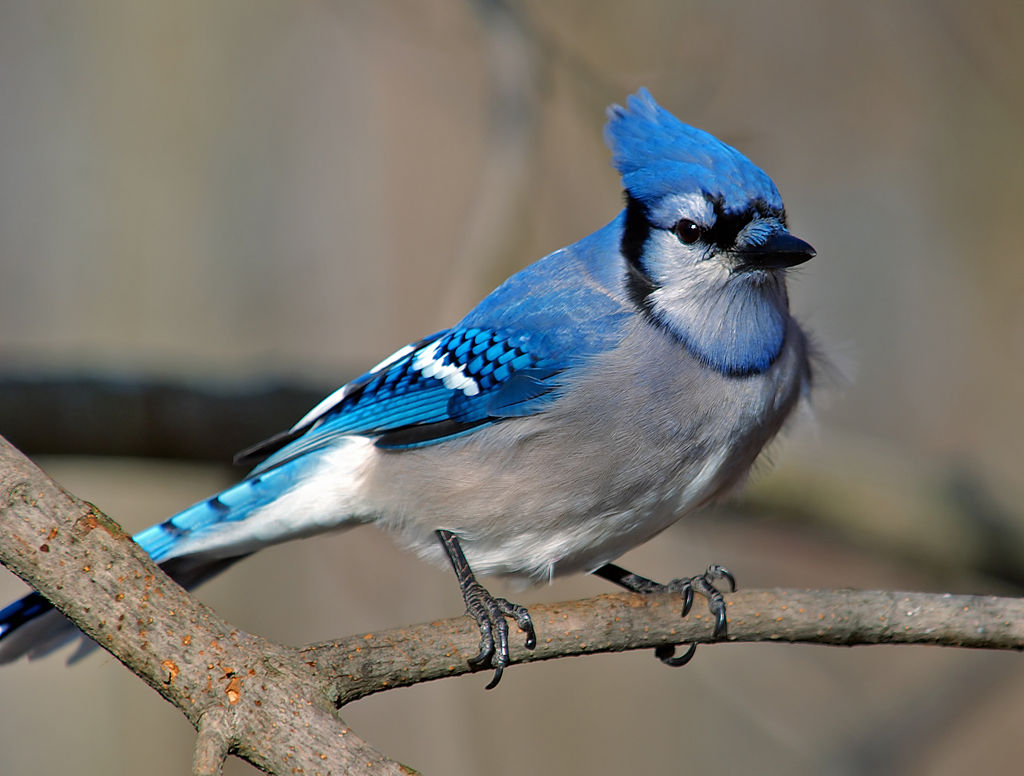
Coloration and Markings: Blue Jays have brilliant blue backs and blue wings with a wingbar on each as well as a mix of large, black outlined white ‘scale’ patterns on the blue and smaller scales of lighter blue as you look towards the ends of the wings. They have a white breast and underbelly and the white continues to the underside of the tail and is also present on the neck, showing just over the wings. Facially, this bird has a majestic blue crest and a black line goes from the back of this crest, circling at the throat to the other side of the head. These birds have small, ‘zigzag’ style masks and long, straight black bills.
Size: These birds measure in at 9.8 – 11.8 inches in length with wingspans of 12.4 to 16.9 inches.
Habitat: Blue Jays hang out most often in woodlots and at the edge of the woods, but they aren’t afraid of visiting parks or residential areas.
Diet: These birds love acorns but as far as feeder-fare, they like cracked corn, Black Oil Sunflower seeds, assorted berries, and are especially fond of peanuts.
Carolina Wren – Thryothorus ludovicianus

Coloration and Markings: Carolina Wrens are small and cute, with brownish-red backs, wings, and perky, medium-length tails. On their wings and tails you will see some black and white ‘checkerboard’ etching and the breast and underbelly of this bird are a warm, yellowy-orange. Facially, these birds have brown-red faces with white chins and cheeks, with a little black peppering underneath the eye and a large eyebrow line above it. These birds have medium-length, slightly curved black bills.
Size: These little birds measure in at 4.7 – 5.5 inches from head to tail with wingspans of approximately 11.4 inches.
Habitat: Carolina Wrens are often heard singing from somewhere you just can’t seem to spot them. This is on purpose, as these are birds of brambles, thickets, and thorns. If you have some bushes in your backyard then this will help in your chances of a visit!
Diet: These birds love peanuts, Black Oil Sunflower seeds, and suet. Be sure to include one or more of these feeders and you are ready to host a birdy-luncheon!
Northern Cardinal – Cardinalis cardinalis
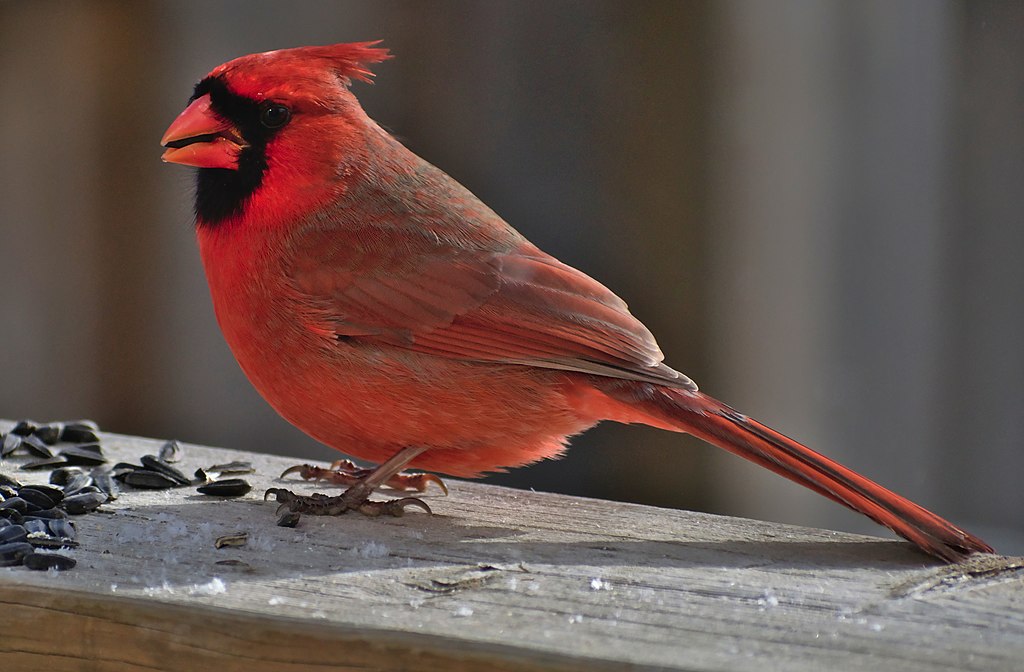
Coloration and Markings: The iconic Northern Cardinal is hard to miss and is responsible for many people taking up the hobby of birding in the first place. This bird is almost completely red, though occasional grays may be seen in the wings and tail. The exceptions to the ‘red-only’ rules for this bird are its exquisite black mask just under its formidable crest and it’s bill. This mask covers the eyes and the chin, and the bill in question is short, stout, conical, and deep orange in color Females are brown but will have traces of red throughout their plumage.
Size: These birds measure in at 8.3 – 9.1 inches in length with wingspans of 9.8 to 12.2 inches.
Habitat: While you might spy a Cardinal at the edge of the woods it is more likely that you will see them in a local park or the city proper. In spring they look for dense vegetation for nesting so keep your eyes peeled there as well.
Diet: Northern Cardinals are easy to please. Add some crushed peanuts, milo, Safflower or Black Oil Sunflower seeds, or simply cracked corn to your feeder. These are all favorites and might well earn you some repeat visits.
Eastern Towhee – Pipilo erythrophthalmus

Coloration and Markings: Eastern Towhees have simple but elegant coloration. Their back, wings, and short, fanning tails are black with a few white feathers on the wings and white outer tailfeathers. The breast of this bird is white in the center with dark orange flanking the sides which thins out as it approaches the white underbelly. Facially, from its small, black crest to the base of the throat this bird is black and it has a short, stout conical black bill. Females will have the same style to their bodies but will be a rich brown where the males are black.
Size: These birds measure in at 6.8 – 8.2 inches in length with wingspans of 7.9 to 11 inches.
Habitat: Eastern Towhees like dense vegetation for foraging, so don’t be surprised if you accidentally scare one out of a bush or some brambles in the woods. This is where they like to forage for the safety that such cover provides.
Diet: You will want to load a ground feeder with a few of these bird’s favorites, such as peanuts, wheat, oats, cracked corn, or milo for best results.
Northern Mockingbird – Mimus polyglottos

Coloration and Markings: The Northern Mockingbird has a brown-gray back, wings, and a long, brownish-gray tail with white outer feathers. You will notice two wingbars on each wing and large, white patches which are quite visible when this bird is in flight. The breast and underbelly of this bird are whitish with the brightest color being on the breast and becoming ‘dirty’ white as the coloration approaches the underbelly. Facially, this bird has a white lower face with some thin, gray outlining from the back of the eye which traces the cheek and terminates underneath the bill. The upper half of this bird’s face is a soft gray and it has a small, slightly-curved black bill.
Size: These birds measure 8.3 – 10.2 inches from tip to tail and have wingspans of 12.2 to 13.8 inches.
Habitat: These birds like open areas such as fields and the forest’s edge. They also spend a lot of time in parks and the suburbs, checking out backyards to see if someone is thinking of them. Be sure to leave a little out and you might get a few songs from your new friend.
Diet: Seeds are not so effective with this bird but some chopped up oranges or apples can get and keep the Northern Mockingbird’s attentions.
Alabama’s Birds of Spring, Summer, and Early Fall
When the daffodils start blooming then look out! Spring has officially arrived in Alabama. A number of birds will be arriving to make the most of the Alabama spring and will likely stick through summer and the beginning of fall before moving on to warmer parts for the winter. See if you can spot a few of these Alabama birds of spring, summer, and early fall:
- Indigo Bunting
- White-eyed Vireo
- Carolina Chickadee
- Ovenbird
- Scarlet Tanager
Indigo Bunting – Passerina cyanea

Coloration and Markings: Indigo Buntings are beautiful and quite easy to identify. The males are a rich Indigo blue all over their bodies, though you might see the occasional gray in their plumage. Their faces are a richer concentration of the same blue color and they have short and stout silvery bills. Females will be brown with some blue occasionally showing throughout the plumage but it will be faint. They will exhibit streaking on the breast and the throat will be light colored, almost white.
Size: These little birds measure in at 4.7 – 5.1 inches in length with wingspans of 7.5 to 8.7 inches.
Habitat: When these birds aren’t spending time at the forest’s edge they range out, looking for thd cover of shrubs, brambles, thickets, and high weeds or grass. They will happily visit your backyard feeder but if you have any bushes which they can hide in then this will increase your chances of a visit.
Diet: These birds are easy to please, you can give them Nyjer thistle and small or broken up Black Oil Sunflower seeds.
White-eyed Vireo – Vireo griseus

Coloration and Markings: White-Eyed Vireos have yellow-green backs with gray wings which exhibit 2 wingbars and are yellow-tinged. They have medium-length gray and yellow tails and the breast and underbelly of this bird are white, flanked with yellow at the breast. Facially, these birds have a yellow mask-type concentration around the eyes as well as eyering with a line creating a spectacled look. A small, angled black line creates an ‘angry’ eyebrow on this bird and it has a short, slightly curved black bill.
Size: These birds measure in at 4.3 – 5.1 inches in length with wingspans of approximately 6.7 inches.
Habitat: These birds loves the forest’s edge and any form of dense surubberies, such as thickets, brambles, and brush.
Diet: While primarily insectivorous, these birds do love fruits. They are a little shy of feeders, preferring to go after your blackberry vines or other garden fruits with a little more cover than the feeder, but you might have lucky with some chopped apples and cherries or some other fruits that you have on hand.
Carolina Chickadee – Poecile carolinensis
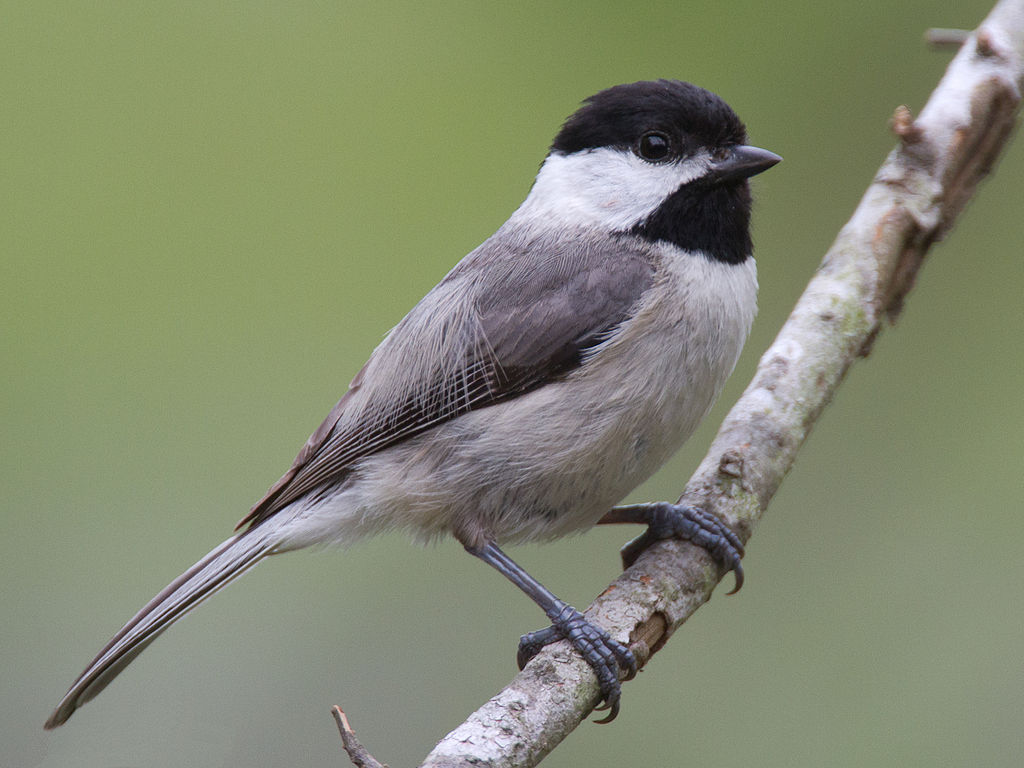
Coloration and Markings: Simple but elegant, the Carolina Chickadee has a velvety gray back, wings, and medium-length, rounded gray tails. They have a white breast and underbelly and facially, these birds have white faces with a black bib and a large, black cap which goes from the top of the head, all the way across, and stops at the center of the eye. These birds have tiny, conical black bills.
Size: These birds are tiny, measuring in at 3.9 – 4.7 inches in length with wingspans of 5.9 to 7.9 inches.
Habitat: These little guys are not shy, confident in their ability to evade humans and other birds. They are at home in the woods, parks, and backyards where they will happily visit your feeder for snacks.
Diet: Carolina Chickadees are not difficult customers when it comes to feeding-fare, just leave some suet, crushed peanuts, and Black Oil Sunflower seeds out for them and they will be happy little songbirds.
Ovenbird – Seiurus aurocapilla

Coloration and Markings: Ovenbirds have olive-green backs, wings, and medium-length, quite animated olive tails. Their breast and underbelly are white with distinctive black spots which become streaks on the face, stopping just under the bill. Above this, the face is olive-green with the exception of the black and orange minute striping which occurs at the crown of this bird’s head. A thin but distinct eyering is present and this bird has a small, medium-length dark gray bill which is conical in appearance.
Size: These birds measure in at 4.3 – 5.5 inches from head to tail with wingspans of 7.5 to 10.2 inches.
Habitat: These birds like deciduous and coniferous woods (in that order) though they like them dry, avoiding any areas with a lot of water.
Diet: While they primarily eat insects, Ovenbirds will occasionally go after suet. You can hedge your bets by trying suet along with dried crickets and mealworms.
Scarlet Tanager – Piranga olivacea
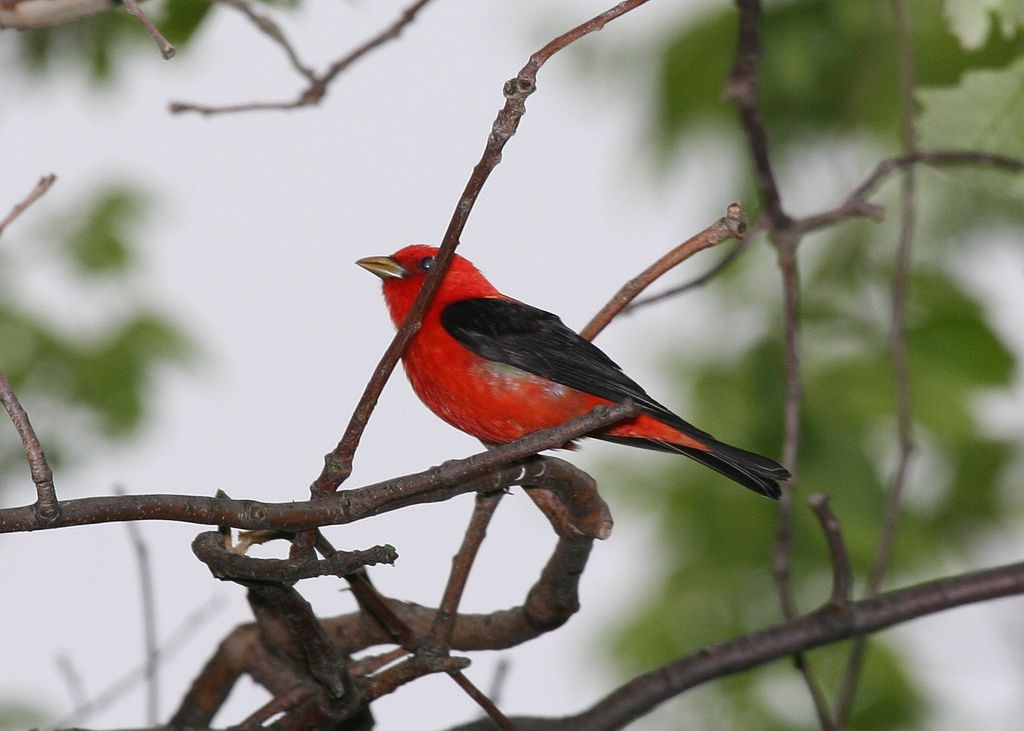
Coloration and Markings: When it is warm out the male Scarlet Tanager is almost impossible to miss. This bird is completely deep red in color, with the exception of its black wings (with a yellow mark sometimes on the shoulder), tiny black tail, and its medium-length, slightly curved yellow bill. Females and juveniles will be olive green, rather than red, and have dark wings but not quite black. Males will shed their red color after mating season and replace their olive green with red but may still be identified by the distinctive black wings.
Size: These birds measure in at 6.3 – 6.7 inches in length with wingspans of 9.8 to 11.4 inches.
Habitat: These birds prefer undisturbed Evergreen and deciduous forests. They do range out on occasion, preferring parks and backyards that have a little cover in the form of shrubs, brambles, or bushes.If you don’t have those, don’t worry, if your feeder is stocked and this bird notices then you will likely get a visit anyway.
Diet: You can attract the Scarlet Tanager to your feeder sometimes with suet, chopped up oranges, mealworms, or grape jelly. Try the last one if you get a chance. Many birds seem to love grape jelly and this is considered a veteran birder trick that really works.
Alabama’s Fall and Winter Birds
With lows reaching only 31 degrees Fahrenheit, Alabama has some fairly mild winters. While some birds bail we’ve found a few who stick through the winter and do just fine in it. Be sure to leave out some feeder snacks to help these guys out in the cold if you see them:
- Chipping Sparrow
- Eastern Phoebe
- American Goldfinch
- Yellow-bellied Sapsucker
- Swamp Sparrow
Chipping Sparrow – Spizella passerina
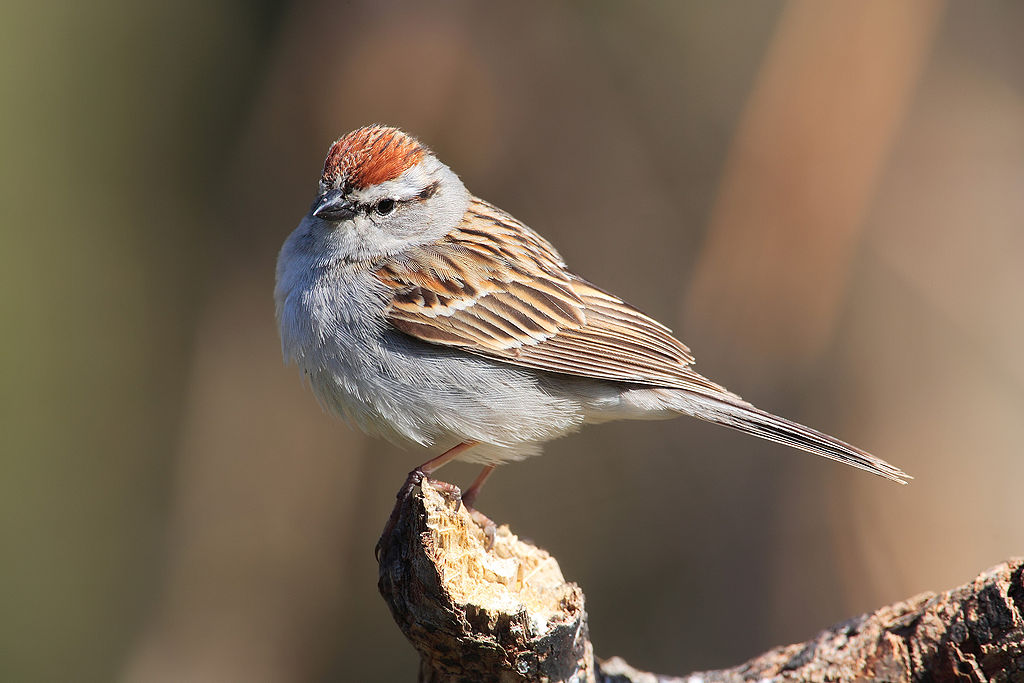
Coloration and Markings: Chipping Sparrows have brown and gray backs and wings, with heavy brown coloration on these parts of their bodies and heavy vertical dark streaking is present on the wings. Their medium-length, somewhat rounded tails tend to be gray and their breast and underbelly are a dirty gray color, sometimes with darker coloration in the center of the breast. Facially, these birds have gray faces, with a darker gray concentration framing the cheek just above a faint whitish mustache line. A black eyeline present, which stops at the back of the head and a faint white half-eyering is sometimes visible below the eye. This bird has a small but distinct rufous colored crown with a bit of black at the end in front of the forehead. This black portion is just above asmall, sout black bill. When it is cold out, their coloration is still present but noticeably muted.
Size: These birds measure 4.7 – 5.9 inches in length with wingspans of approximately 8.3 inches.
Habitat: These birds prefer open woods, meadows, fields, and clearings, though they often range to local parks and backyards when foraging for their meals.
Diet: Black Oil Sunflower seeds and Nyjer thisle will work with this bird but be sure toscatter a bit at the base of the feeder, as these birds are ground foragers and prefer to get their seeds that way.
Eastern Phoebe – Sayornis phoebe

Coloration and Markings: Eastern Phoes have simple, soothing coloration. They have soft gray back, wings, and a medium-length gray tail. Some thin, white edging is visible on the wings, including lines that look to be aspiring to be wingbars (but only show as thin, defining lines). The breast and underbelly of this bird are a snow white and that coloration goes up to just below the chin, peeking out thinly above the wings at level with the throat. Facially, these birds have a split-coloration, with light gray under the eyes and a darker gray above it, horizontally sectioned, and they have short, straight black bills. In the fall you might see a yellowish cast to the breast but beyond this there is not much change in the Phoebes color scheme.
Size: These birds range in length from 5.5 – 6.7 inches and have wingspans of 10.2 to 11 inches.
Habitat: These birds love the open woodlands, spending time in meadows, general clearings, and at the forest’s edge. They are also quite comfortable around inhabited areas, often making nests in buildings in the spring.
Diet: These birds like to eat insects and will likely ignore your feeder, though you can try leaving out some dried crickets or mealworms. If they notice these then you might get lucky.
American Goldfinch – Spinus tristis

Coloration and Markings: Males are quite distinctly colored, with bright yellow back, breast, and underbelly with some white coloration beginning at the rump and extending to the underside of the tail. The wings and tail of this bird are black, with some white at the shoulder and a distinctive wingbar on each wing, as well as some vertical and assorted white striping towards the tips of the wings and extending onto the black tail. Facially, this bird has a bright yellow head with a black cap, hung at a rebellious angle in that it starts from the center of the head and goes down to the small, conical orange bill. Females have muted yellow coloration and they are olive colored where the males have black, and in the winter both birds molt into less conspicuous plumage. They appear then as an unstreaked brown but still display the distinctive black wings with less vibrant wingbars.
Size: These bright little birds measure in at 4.3 – 5.1 inches in length with wingspans of 7.5 to 8.7 inches.
Habitat: The American Goldfinch likes to forage in open areas which frequently flood as well as fields with high weeds or other dense vegetation. They are brave, however, and it’s not uncommon to see them in parks, orchards, gardens, or at backyard feeders.
Diet: These birds aren’t so picky, a simple mix of Nyjer Thistle and Black Oil Sunflower seeds may get and keep their attentions.
Yellow-bellied Sapsucker – Sphyrapicus varius
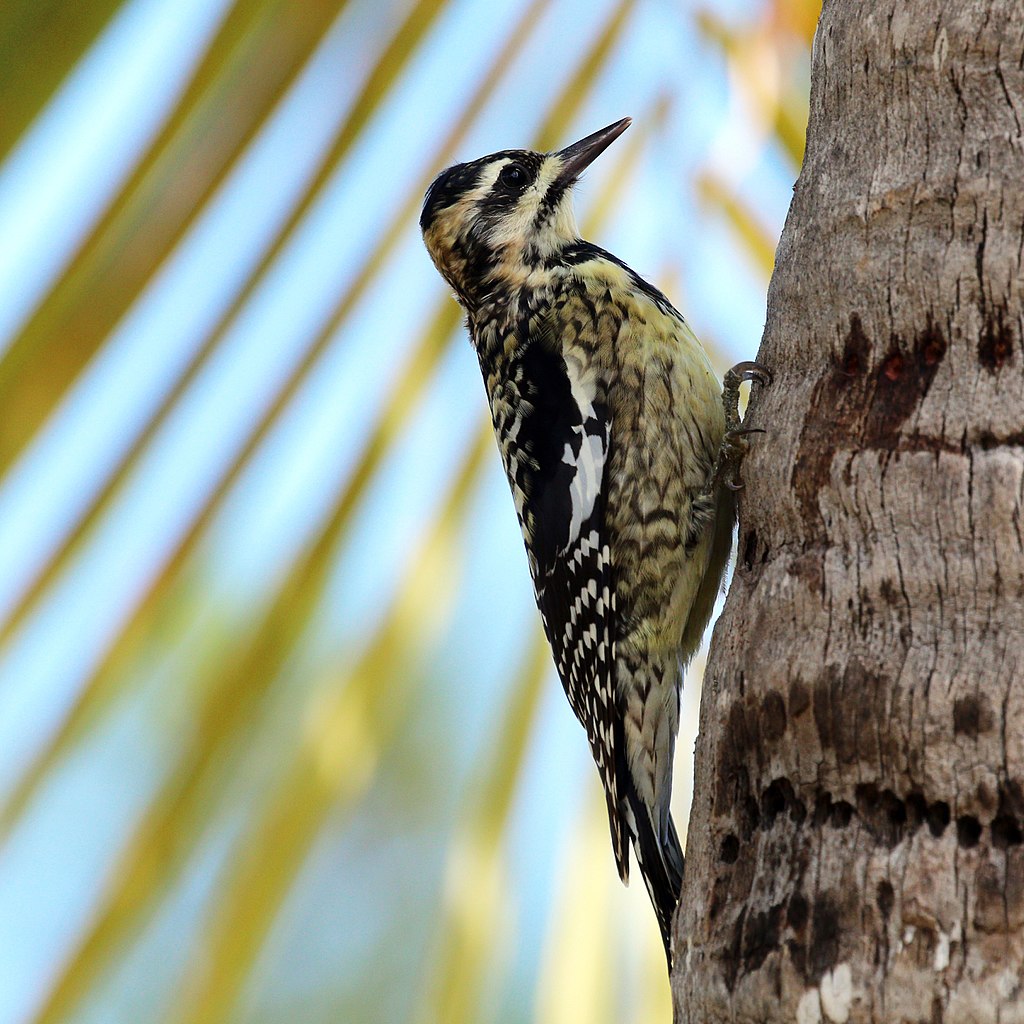
Coloration and Markings: Yellow-bellied Sapsuckers have a somewhat chaotic-looking coloration scheme but there are some distinctive features to look for. Their backs are typically white with black spotting while their wings are black with a distinctive wide white stripe on each wing and a minute checkerboard black and white edging towards the wingtips. They have short, black tails with white undersides and the breast of this bird is white flanked with gray spots that diminish in width and frequency as they approach the white and faintly yellow underbelly. Facially, this bird has a small, red bib edged in a thick back outline beneath while the face is mostly white with some exceptions. This bird has a a black mask that continues towards the back of the head, terminating as it curls around the cheek, and while in front of the eye it curved up around the forehead, just under a red half-cap. These birds have medium-length, straight black and silver bills with the color evenly divided between the upper and lower bill.
Size: Roughly the same size as the American Robin, these birds measure in at 7.1 – 8.7 inches in length with wingspans of 13.4 to 15.8 inches.
Habitat: These birds like conifer and hardwood forests but they do a bit of ranging from time to time (especially in winter). At these times you might see them in parks or in your own backyard, foraging for meals or snacks.
Diet: Aside from insects, these birds like to eat tree sap as well as nuts and assorted fruits. Try leaving out some chopped apples, peanuts, and some chunky peanut butter and you might just get the attention of a hungry Yellow-bellied Sapsucker.In winter, be sure to add suet into the mix as they like this as well and it gives them energy for keeping off the chill.
Swamp Sparrow – Melospiza georgiana

Coloration and Markings: Swamp Sparrows have lovely auburn backs with black vertical stripes as well as short auburn wings which display dark streaking. They have long, brownish tails and a gray breast flanked with touches of gray in an olive-brown coloration that keeps the gray central until it reaches the rump. At the rump, the brownish coloration takes over completely and includes dark spots. Facially, this bird has a mostly gray face, excepting a small, white bib and some olive-brown coloration outlined in black at the cheek and just short of underneath the eye. Above this, the underside of the eye is gray and this curves around the front of the eye, down the neck, and inward until terminating under the olive cheek outlining, just even with the center of eye. This bird has a bicolor cap, with rich brown in the center and shiny black on both sides of it and a tiny, straight yellow bill which is often black-tipped.
Size: These birds measure in at 4.7 – 5.9 inches from tip to tail and have wingspans of 7.1 to 7.5 inches.
Habitat: True to their name, these birds like to frequent areas where this is water. This can include flooded fields, swamps, or close to ponds and they prefer these places to have a bit of dense cover whenever possible for protection against predators.
Diet: These birds consume insects and seeds, for the most part, but one of their little-known favorites is Blueberries. Try adding fresh or dried Blueberries to your feeder with some Nyjer thistle on the side and you might just get the Swamp Sparrow’s attention.
Supporting cast (Other Backyard Birds of Alabama that might pay you a visit)
Aside from the year-round birds we gave the premium first-billing to there are a number of other birds that you can see. These lovelies are also year-round residents of Alabama and while they didn’t get the star billing they are certainly stars all on their own. Keep a lookout for these year-round supporting cast birds:
- Tufted Titmouse
- House Finch
- Eastern Bluebird
- Red-bellied Woodpecker
- Mourning Dove
Tufted Titmouse – Baeolophus bicolor
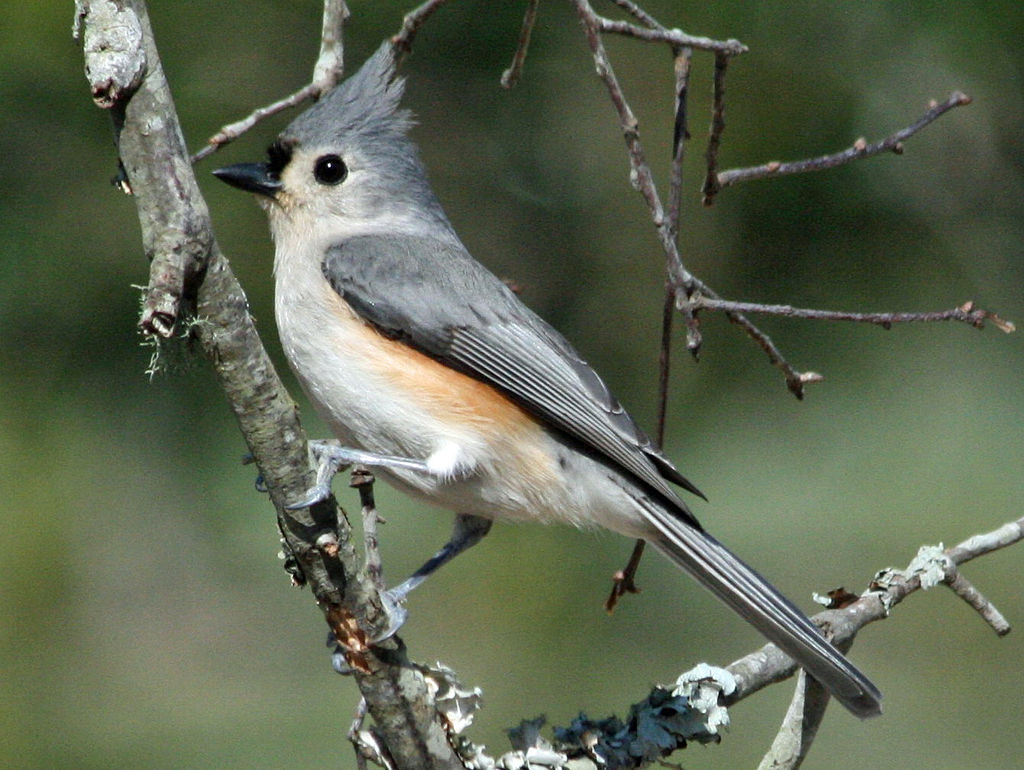
Coloration and Markings: The Tufted Titmouse has delicate, lovely coloration. The back, wings, and long, rounded tails are all a soft gray and blue while the breast and underbelly are paper-white with a light peach-colored wash flanking as you look to the underbelly. The white from the breast moves upward into the face where it stops just under the bill, expanding horizontally to cheek level and outlining the eye above. The rest of this bird’s face is gray-blue and it has a perky bluish crest and a black, square-shaped mark above its tiny, slightly curved black bill.
Size: These birds measure in at 5.5 – 6.3 inches in length with wingspans of 7.9 to 10.2 inches.
Habitat: These birds love Evergreen and deciduous forests and frequently range forth to visit parks, orchards, and backyards.
Diet: These birds will munch on peanuts, suet, and Nyjer thistle if you’ve got it, but their favorite is Black Oil Sunflower seeds. If you stock up on these then you can’t go wrong with the Tufted Titmouse.
House Finch – Haemorhous mexicanus
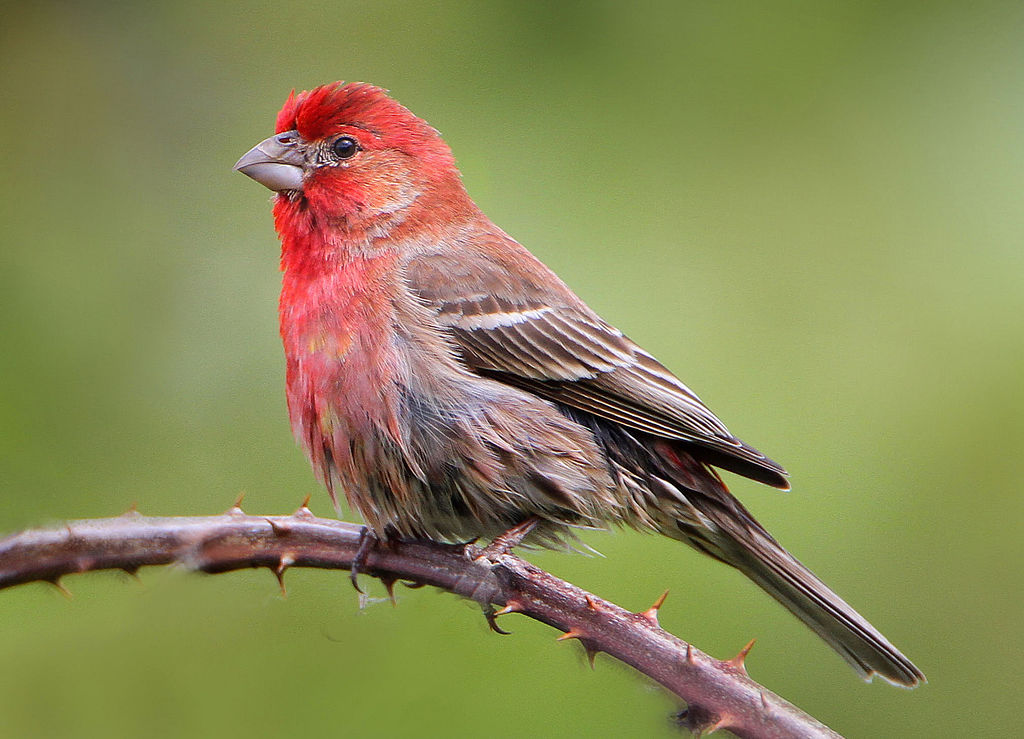
Coloration and Markings: Male House Finches are quite the lookers. They have grayish-bown backs, wings, and medium length tails which are gray with white on the sides. Their wings have a series of vertical stripes and the appearance of two small wingbars on each from the white outlining at the base of 2 upper rows of stripes. The breast of this bird has a heavy saturation of rosy red which tapers into faint red streaking as the color approaches the underbelly. Facially, the House Finch has a rosy face with some gray markings extending from the back of the eye and bifurcating to outline the cheek and go to the back of the neck. They also tend to be gray on the top of the head and around the eyes. These birds have small, powerful bills with a curve on the upper bill. Females are grayish-brown, by contrast, with heavy streaking at the breast and with a lack of definitive face markings.
Size: These birds measure in at 5.1 – 5.5 in length with wingspans of 7.9 to 9.8 inches.
Habitat: When these birds aren’t frequenting the edges of the woods they spend a lot of time at farms or in the city. They have a wide range of habitats but they aren’t shy about people and will visit parks and backyard feeders fearlessly. Be sure to leave a little something out for them and you might make some new friends!
Diet: These birds eat mostly insects but small fruits and berries are also used to supplement their diets. Try adding some chopped up apples or plums and some whole Blueberries or chopped up Strawberries. They also like Black Oil Sunflower seeds, if you have some around. Stock up your feeder with any or all of these items and once they take notice you’ll have some very happy Finches.
Eastern Bluebird – Sialia sialis
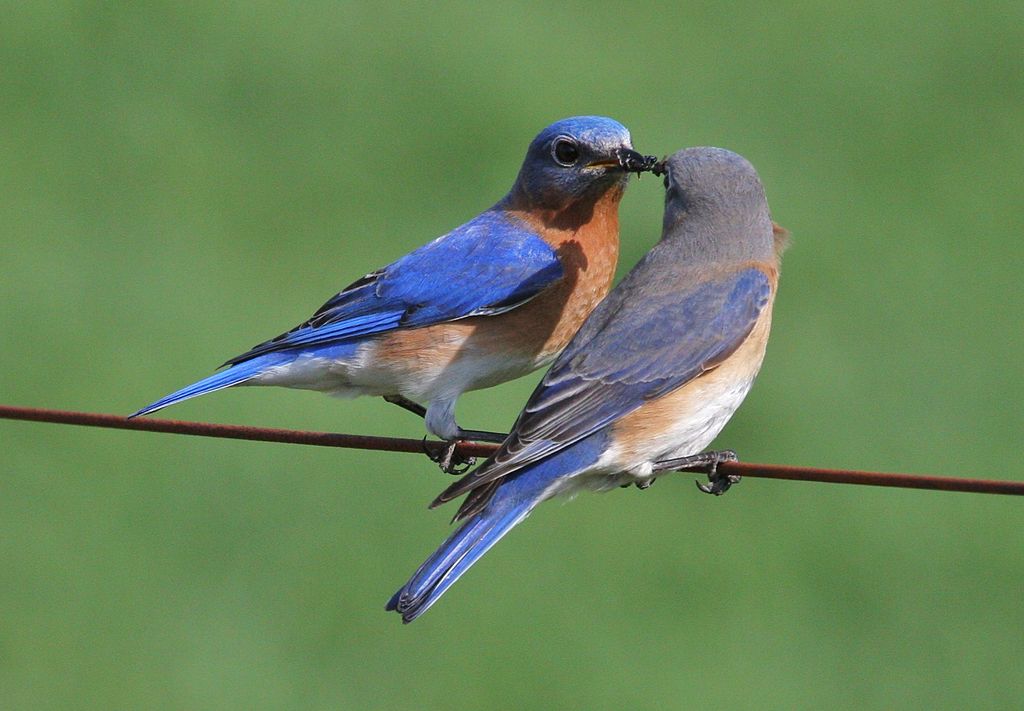
Coloration and Markings: Eastern Bluebirds have brilliant blue backs, wings, and little tails, with some black showing at the tips of the wings and minutely as accent on the tails. They have orange to red-orange coloration on their breast, with white in the center as if wearing a vest, and the orange extends up in the form of a throat-collar that goes to a spot just short of the back of the head and is plainly visible above the wings. Moving down to the underbelly, the vest becomes thinner until it is gone and some gray coloration is often present, creating a ‘dirty white’ color except at the rump which is completely white. Facially, this bird’s face is completely blue above the orange collar and it has a medium-length, slightly curved gray bill. Females have more muted coloration, with the backs tending to be gray and their blues and oranges very dim.
Size: These birds are approximately 6.3 – 8.3 inches from head to tail and have wingspans averaging 9.8 to 12.6 inches in length.
Habitat: These birds like their Nature with a lot of viewing room, preferring open areas in the woods such as meadows or in the suburbs, golf courses and parks. They are happy to visit backyard feeders providing that they are stocked and your backyard is not too crowded.
Diet: Eastern Bluebirds like a lot of foods and you can tempt them with selections such as suet, hulled Black Oil Sunflower seeds, fruits, and even cornbread! Try a little cornbread with some grape jelly on top and see what happens, you’ll be happy that you did!
Red-bellied Woodpecker – Melanerpes carolinus

Coloration and Markings: Red-bellied Woodpeckers have black and white ‘zebra-striped’ backs, wings, and medium-length tails. White patches are sometimes visible towards the tips of the wings when this bird is in flight and it has a white breast and underbelly with light red washes of color present. It looks a little like someone spilled light-colored juice on the bird. Facially, the birds face is mostly white with the red wash present and a long, red cap from the top of its bill to the base of its neck. This bird has a medium-length, straight black bill.
Size: On average these Woodpeckers are 9.4 inches in length with wingspans of 13 to 16.5 inches.
Habitat: These birds love the woods and are especially fond of Hickory and Oak trees. They venture out often, however, to visit parks and backyard feeders. If you have some trees in your backyard then this may increase your chances of a visit.
Diet: These birds are easy to please. Just set out some suet, Black Oil Sunflower seeds, and peanuts or chunky peanut butter and the Red-bellied Woodpecker is one happy bird!
Mourning Dove – Zenaida macroura
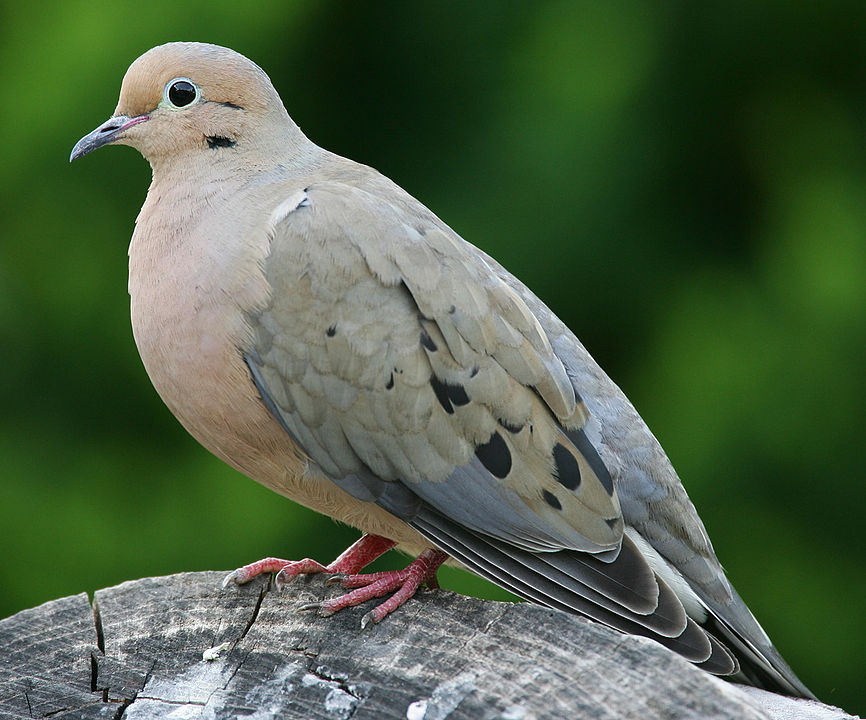
Coloration and Markings: Mourning Doves are easy to identify. They have soft gray backs, wings, and long, thin gray tails with a heavy dose of creamy tan coloration present towards the central portion of the wings. There are also large and quite distinctive black spots present here as well. The breast and underbelly are a combination of white and tan color while the face has a richer tan that really brings out this bird’s distinctive white eyering. These birds have medium-sized, straight black bills.Their coloration may vary a bit based on location but if you look for these markings and colors you should still have no issues identifying the Mourning Dove when you see it.
Size: About the same size as the American Robin, this bird measures in at 9.1 – 13.4 inches from head to tail with a wingspan on average of 17.7 inches.
Habitat: These birds avoid the woodlands, with the occasional exception of their edges. Most commonly they may be found in farms or in the city, where you can see them on fences, phone lines, or even taking a wobbly-walk down the sidewalk. These birds are quite comfortable around people and more than happy to visit feeders.
Diet: Cracked corn, wheat, and Black Oil Sunflower seeds are 3 easy foods that will make the Mourning Dove much less somber. Stock up on these and you might just get a visit.
Alabama Bird Buffet
If you are looking to attract the most birds possible to your feeder then we have some recommendations from the Alabama Cooperative Extension System as well as a few of our own. Setting up the right combination for attractive a number of diverse birds may take a little trial and error but the items suggested below should get you well on your way to that perfect feeder configuration. Give these items a try and see what happens:
- Black Oil Sunflower
- White Proso millet
- Cracked corn
- Safflower
- Peanut hearts
- Grape jelly
- Chunky peanut butter
Alabama Birding Hot Spots
If you want to find, see, and maybe photograph the stars of the Alabama skies like a real Chirparazzo then we’ve got some hot tips for you! The locations below are selected so that whatever part of the state you might be in they should be fairly accessible. If the spot in your region is too far, simply check out our reference link and you are sure to find something just around the corner. Be sure to visit one or more of the following sites when you want to up your Alabama birding game:
- Northern hotspot – Madison County Public Lake
- Eastern hotspot – Alligator Creek Nature Trail
- Southern hotspot – Leon Brooks Hines Public Lake (Escambia County Public Lake)
- Western hotspot – Moundville Archaeological Park
- Central hotspot – Ebenezer Swamp Ecological Preserve
Detailed descriptions of each location as well as information regarding visiting and what birds you can see at these locations may be found at https://alabamabirdingtrails.com/map/
Some Final Commentary
That concludes our quick trip into the fantastic world of Alabama birding. With so many different environments housed in one state Alabama is definitely a great place to be a birder. Just be sure you’ve got your binoculars handy and your feeders stocked appropriately and between the backyard and those hotspots you’ll be checking a lot of birds off of your first-sightings list! Until next time, happy birding and don’t forget to bring a lunch… and just a little patience.
